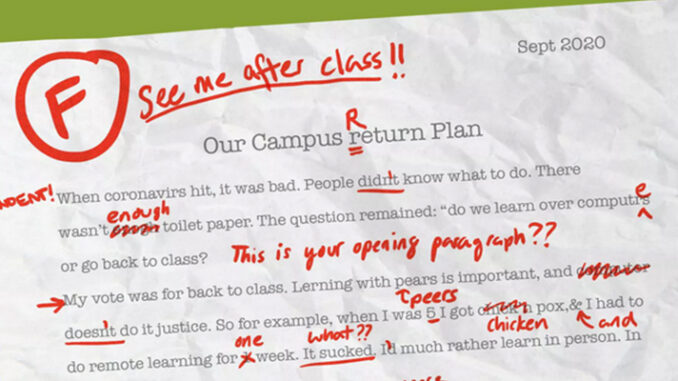
While completing these programs helps more students earn diplomas, many students — as many as one-third in one study — fail to earn credit from their credit recovery courses.
by Betheny Gross
In a year of educational crisis, fall report cards brought more troubling news.
Failing grades are on the rise across the country — especially for students who are learning online. Worrying data points are emerging across the country: In New Mexico, more than 40 percent of middle and high school students were failing at least one class as of late October. In Houston, 42 percent of students received at least one F in the first grading period of the year. Nearly 40 percent of grades for high school students in St. Paul, Minnesota were Fs — double the amount in a typical year. In California’s Sonoma County, 37 percent of students across 10 districts had at least one failing grade, compared with 27 percent last year.
The trend threatens to exacerbate existing educational inequities. The rise in failing grades appears to be most pronounced among students from low-income households, multilingual students and students learning virtually. And this could have lasting consequences. Students with failing grades tend to have less access to advanced courses in high school, and a failing grade in even one ninth-grade course can lower a student’s chances of graduating on time.
Addressing the problem won’t be easy. In many school systems, the rash of failed courses could overwhelm traditional approaches to helping students make up coursework they may have missed. School and district leaders should be especially wary of one long-established but questionable practice: credit recovery.
Before the pandemic, 1 in 13 U.S public high school students participated in credit recovery, programs that offer condensed, customized coursework to help teens who fail classes get back on track to graduate.
But while completing these programs helps more students earn diplomas, many students — as many as one-third in one study — fail to earn credit from their credit recovery courses. Even when students do complete the courses, some studies have found they do little to help students actually learn the content they missed.
Researchers have pointed out the rising popularity of credit recovery coincides with both a rise in high school graduation rates and stagnant high school performance on national reading and math tests. This underscores a paradox, that while recovery can help students make up credits, it may be less effective at helping them make up for real learning.
As we now confront pandemic-related learning losses, and aim to accelerate learning in hopes of catching students up, schools need to throw out their expectations surrounding what curriculum should be covered when and instead try to support students via individualized learning pathways.
Leaving this problem unaddressed could worsen inequity. The students who are most at risk of lasting academic harm from failing grades are students who have been learning remotely, students living in poverty, multilingual learners, and students of color. Of course, there tends to be significant overlap among these groups.
Families of color are more likely to live in school districts offering only remote instruction and are more likely to opt for remote learning when in-person learning is available. And students who continue remote learning may also be more likely to fall behind on coursework. For example, Cypress-Fairbanks Independent School District, the second-largest district in greater Houston, reported 41 percent of online-only middle and high school students failed at least one class, compared with 15 percent of those attending in-person instruction.
Multilingual learners may also be at high risk for failing grades. In Fairfax County, Virginia, the biggest drop in grades came for students whose primary language is not English: 47 percent are underperforming in math, 53 percent in English.
Students from low-income households also see greater increases in failing rates. In Montgomery County, Maryland, 36 percent of ninth-graders from low-income households failed the first marking period in English, compared with 6 percent last year, when the same students took English in eighth grade.
If these trends continue, the number of students who will need help getting back on track academically will far exceed what we’ve seen in the past. Three principles can help schools prepare to confront this looming challenge:
- Don’t rely too heavily on credit recovery. When students fail classes, many districts enroll them in credit recovery courses, which are increasingly online. But even putting aside the concerns about its effectiveness, credit recovery is ill-suited to the challenges educators are likely to face in COVID’s wake because pandemic-related learning losses are expected to affect a vast cross-section of students, not just the fraction who fall behind during a typical school year.
- Rethink student progress. Virtual instruction disrupted the learning progression for a great many students. Early results from NWEA’s MAP assessments also show students may be keeping closer to their typical pace in reading than in math. A middle school will likely face wider variation in learning within its eighth-grade class than it would in a typical year. And it could also see more individual students who are ahead in one subject, but behind in another. As one superintendent noted during an interview with CRPE researchers, “Grade levels just don’t mean as much anymore.” As districts think about helping students recover what they’ve lost, they should consider a proficiency-based approach that maps out learning progressions, identifies learning targets, and provides varied and flexible strategies and interventions to support students to progress along those pathways from whatever their starting point is.
- Flood students with support. The sheer number of students who will need additional support in the coming months and years, along with the widely divergent learning experiences they have had, suggests the need for an all-of-the-above strategy. Elaine Allensworth and Nate Schwartz in their Ed Research for Recovery brief point to intensive tutoring, extended learning time, and systems to monitor student progress and early warnings as high-value interventions to support students. Districts should also start thinking now about how to take advantage of next summer to get a jump-start on learning for next fall — an opportunity too many districts left untapped last year.
Doing these things will require schools to rethink their use of resources, staffing, and curriculum. Time is of the essence to start planning.
Betheny Gross is associate director of the Center on Reinventing Public Education at the University of Washington Bothell.



